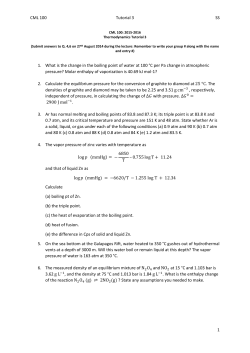
CHEM 433 Name: ___________________________________ FALL 2010
CHEM 433 FALL 2010 Sample EXAM #1 [80 Points] Name: ___________________________________ DIRECTIONS & SUGGESTIONS: You have 2 hours to complete this exam. WORK EFFICIENTLY! Look the whole exam over before you begin working: do the problems you know first, then return to the ones that are less obvious to you. Write out legible solutions to all the “problems” and “short answer” questions on the paper provided. Answer multiple choice and the trends in #8, on the exam copy itself. Please number, and put your name on each page you turn in. When you are finished, please staple all your pages to the back of this exam, in order, cover page intact. Some useful data and equations: 1 J = 1 N m = 1 kg m2/s2 1 L = 1 dm3 = 10-3 m3 1 atm = 760 Torr T(°C) = T(K) + 273 1 bar = 105 Pa = 105 N/m2 P= nRT RT = V Vm P= RT a − 2 Vm − b Vm ΔU = q + w 1 atm = 101325 Pa k = 1.38 x 10-23 J/K Z= NA = 6.02 x 1023 molec./mole Vm PVm = V °m RT Vf R = NAk = 8.314 J/K mole w = − ∫V pext dV i R = 0.08206 L atm / K mole R = 62.36 L Torr/ K mole € Cv = ⎛ ∂U ⎞ ⎝ ∂T ⎠ v PV=nRT 1 I. Multiple Choice. [20 Pts./4 each] Circle the best answer(s) (i.e. account for silly round off errors). (And yes, “answer(s)” means there can be more than one!) 1. Which of the following are intensive properties? a) Pressure (p) c) Constant Volume Heat Capacity (Cv) b) Internal Energy (U) d) Molar Volume (Vm) 2. Of what functional form is the distance dependence for the potential energy of an ion – dipole interaction? a) V~1/r c) V ~ 1 / r3 b) V ~ 1 / r2 d) V ~ 1 / r4 3. Which of the following statements regarding the compression factor (Z) is not correct? a) Z = 1 for an ideal gas c) Z > 1 if repulsive forces predominate b) Z < 1 if repulsive forces predominate d) Z cannot be negative 4. 2.0 moles of an Ideal Gas with Cv,m= 3R are heated from 273 K to 298 K what is the change in internal energy (ΔU) for this process? a) + 1.25 kJ c) – 0.62 kJ b) + 0.62 kJ d) None of the above 5. Which of the following are exact differentials? a) df = 2xy dx + y2dy c) df = ex dx + ey dy b) df = y2 dx + 2xy dy d) df = ey dx + ex dy 2 II. Molecular Energies [20 points] 6. Consider the expression below for the molar internal energy (Um) of an ideal gas composed of nonlinear, polyatomic molecules. Um = Um(0) + 3 RT a) Physically justify both terms in this equation. That is: i) What types of energy does the “Um(0)” term represent, and why can it be regarded as a constant (w.r.t. temperature, so long at T is reasonably low)? ii) What types of energy does the “3RT” term represent? Explicitly rationalize this using the equipartition theorem. b) From the equation above, derive the molar constant volume heat capacity (Cv,m) for a non-linear, polyatomic gas. c) Conceptually, why is Cv,m greater than for a polyatomic gas, than for a gas composed of linear molecules or atoms? III. Expansion Work and the 1st Law [20 points] 7. Consider the process in which a sample of gas expands reversibly and isothermally from 22.4 L to 44.8L, at 298K. Vf a) Recall the general formula for work: w = − ∫ pext dV , and that the system is essentially at V i mechanical equilibrium during a reversible expansion, such that pext= p (i.e. the p of the system) during the entire process. Use this information to derive the expression below for the work during ⎛ V ⎞ a reverisble isothermal expansion: w = −nRT ln⎜ f ⎟ ⎝ Vi ⎠ b) Use the formula you presumably derived in “a” to calculate the value of the work, in units of J. € c) What is ΔU for this process? d) How much heat is transferred during the process, i.e. what is the value of q (which the correct sign as it pertains to the system)? 3 VI. IMF, Bulk Properties, and non-Ideal Gases [20 Points] 8. Examine the table below which shows boiling temperatures (Tvap) for the hydrides of group 16 (shown in order as one proceeds down the oxygen column in the periodic table). The key here is to make the connection between boiling temperature and the relative strength of attractive forces for a given substance. Substance H2 O H2 S H2Se H2Te Tvap (K) 373 213 231 271 i) Atkins states explicitly that “dispersion forces typically dominate all other types of intermolecular forces except hydrogen bonds”. Does this data support or contradict this statement? Why? Make specific references to various types of forces, and factors that affect their strength (Te and H have approximately the same electronegativity, Te being just slightly more electronegative). ii) How should the values of the van der Waals “a” coefficients vary among these substances? Rank them in order of decreasing a values (i.e. Hi to Lo) _________ > _________ > __________ > __________ iii) How should the values of the van der Waals “b” coefficients vary among these substances? Rank them in order of decreasing a values (i.e. Hi to Lo) _________ > _________ > __________ > __________ iv) Consider the plot of the Lennard-Jones Potential for H2O below, and sketch in the approximate curve for H2S on the same graph. (BTW: These molecules are not spheres – and their attractive forces are not independent of orientation. Ignore that issue here, and assume that the overall strength of the attractive forces is accurately reflected in an average sense by the 1/r6 term in the L-J function). 4
© Copyright 2025





















